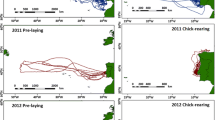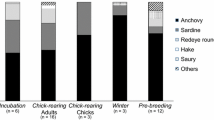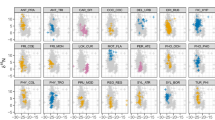Abstract
Information on predator and prey distributions is integral to our understanding of migratory connectivity, food web dynamics and ecosystem structure. In marine systems, although large animals that return to land can be fitted with tracking devices, minimum instrument sizes preclude deployments on small seabirds that may nevertheless be highly abundant and hence major consumers. An increasingly popular approach is to use N and C stable isotope analysis of feathers sampled at colonies to provide information on distribution and trophic level for the preceding, and generally little-known, nonbreeding period. Despite the burgeoning of this research, there have been few attempts to verify such relationships. In this study, we demonstrate a clear correspondence between isotope ratios of feathers and nonbreeding distributions of seven species from South Georgia tracked using loggers. This generated a rudimentary isoscape that was used to infer the habitat preferences of eight other species ranging in size from storm petrels to albatrosses, and which could be applied, with caveats, in other studies. Differences in inferred distribution within and between species had major implications for relative exposure to anthropogenic threats, including climate change and fisheries. Although there were no differences in isotope values between sexes in any of the smaller petrels, mean stable C (δ13C), but not stable N isotope ratios (δ15N), tended to be greater in females than males of the larger, and more sexually size-dimorphic species. This indicates a difference in C source (distribution), rather than trophic level, and a correspondence between the degree of sexual size dimorphism in Procellariiformes and the level of between-sex niche segregation.



Similar content being viewed by others
References
Awkerman JA, Hobson KA, Anderson DJ (2007) Isotopic (δ15N and δ13C) evidence for intersexual foraging differences and temporal variation in habitat use in waved albatrosses. Can J Zool 85:273–279
Bearhop S, Phillips RA, Thompson DR, Waldron S, Furness RW (2000) Variability in mercury concentrations of great skuas Catharacta skua: the influence of colony, diet and trophic status inferred from stable isotope signatures. Mar Ecol Prog Ser 195:261–268
Bearhop S, Waldron S, Votier SC, Furness RW (2002) Factors that influence assimilation rates and fractionation of nitrogen and carbon stable isotopes in avian blood and feathers. Physiol Biochem Zool 75:451–458
Bearhop S, Phillips RA, McGill R, Cherel Y, Dawson DA, Croxall JP (2006) Stable isotopes indicate sex-specific and long-term individual foraging specialisation in diving seabirds. Mar Ecol Prog Ser 311:157–164
Belkin IM, Gordon AL (1996) Southern Ocean Fronts from the Greenwich meridian to Tasmania. J Geophys Res 101:3675–3696
Best PB, Schell DM (1996) Stable isotopes in southern right whale (Eubalaena australis) baleen as indicators of seasonal movements, feeding and growth. Mar Biol 124:483–494
Bolnick DI, Svanbäck R, Fordyce JA, Yang LH, Davis JM, Hulsey CD, Forister ML (2003) The ecology of individuals: incidence and implications of individual specialization. Am Nat 161:1–28
Campagna C, Sanderson EW, Coppolillo PB, Falabella V, Piola AR, Strindberg S, Croxall JP (2008) A species approach to marine ecosystem conservation. Aquat Conserv Mar Freshwater Ecosyst 17:S122–S147
Cherel Y, Hobson KA (2007) Geographical variation in carbon stable isotope signatures of marine predators: a tool to investigate their foraging areas in the Southern Ocean. Mar Ecol Prog Ser 329:281–287
Cherel Y, Hobson KA, Weimerskirch H (2000) Using stable-isotope analysis of feathers to distinguish moulting and breeding origins of seabirds. Oecologia 122:155–162
Cherel Y, Weimerskirch H, Trouvé C (2002) Dietary evidence for spatial foraging segregation in sympatric albatrosses (Diomedea spp.) rearing chicks at Iles Nuageuses, Kerguelen. Mar Biol 141:1117–1129
Cherel Y, Phillips RA, Hobson KA, McGill R (2006) Stable isotope evidence of diverse species-specific and individual wintering strategies in seabirds. Biol Lett 2:301–303
Croxall JP, Nicol S (2004) Management of Southern Ocean resources: global forces and future sustainability. Antarct Sci 16:569–584
Croxall JP, Prince PA (1980) Food, feeding ecology and ecological segregation of seabirds at South Georgia. Biol J Linn Soc 14:103–131
Croxall JP, Silk JRD, Phillips RA, Afanasyev V, Briggs DR (2005) Global circumnavigations: tracking year-round ranges of non-breeding albatrosses. Science 307:249–250
Dale J, Dunn PO, Figuerola J, Lislevand T, Székely T, Whittingham LA (2007) Sexual selection explains Rensch’s rule of allometry for sexual size dimorphism. Proc R Soc Lond B 274:2971–2979
Fairbairn J, Shine R (1993) Patterns of sexual size dimorphism in seabirds of the Southern Hemisphere. Oikos 68:139–145
Forero MG, Hobson KA, Bortolotti GR, Donázar JA, Bertellotti M, Blanco G (2002) Food resource utilisation by the Magellanic penguin evaluated through stable-isotope analysis: segregation by sex and age and influence on offspring quality. Mar Ecol Prog Ser 234:289–299
Forero MG, Bortolotti GR, Hobson KA, Donazar JA, Bertelloti M, Blanco G (2004) High trophic overlap within the seabird community of Argentinean Patagonia: a multiscale approach. J Anim Ecol 73:789–801
Forero MG, González-Solís J, Hobson KA, Donázar JA, Bertelloti M, Blanco G, Bortolotti GR (2005) Stable isotopes reveal trophic segregation by sex and age in the southern giant petrel in two different food webs. Mar Ecol Prog Ser 296:107–113
Fridolfsson AK, Ellegren H (1999) A simple and universal method for molecular sexing of non-ratite birds. J Avian Biol 30:116–121
Gales R (1998) Albatross populations: status and threats. In: Robertson G, Gales R (eds) Albatross biology and conservation. Surrey Beatty, Chipping Norton, pp 20–45
Gladbach A, McGill R, Quillfeldt P (2007) Foraging areas of Wilson’s storm-petrel Oceanites oceanicus in the breeding and inter-breeding period determined by stable isotope analysis. Polar Biol 8:1005–1012
Goericke R, Fry B (1994) Variations of marine plankton δ13C with latitude, temperature, and dissolved CO2 in the world ocean. Global Biogeochem Cycles 8:85–90
González-Solís J, Croxall JP, Wood AG (2000) Foraging partitioning between giant petrels Macronectes spp. and its relationship with breeding population changes at Bird Island, South Georgia. Mar Ecol Prog Ser 204:279–288
González-Solís J, Croxall JP, Afanasyev V (2008) Offshore spatial segregation in giant petrels Macronectes spp.: differences between species, sexes and season. Aquat Conserv Mar Freshwater Ecosyst 17:S22–S36
Griffiths R, Double MC, Orr K, Dawson RJG (1998) A DNA test to sex most birds. Mol Ecol 7:1071–1075
Grosbois V, Thompson D (2005) North Atlantic climate variation influences survival in adult fulmars. Oikos 109:273–290
Harding AMA, Hobson KA, Walkusz W, Dmoch K, Karnovsky NJ, Van Pelt TI, Lifjeld JT (2008) Can stable isotope (δ13C and δ15N) measurements of little auk (Alle alle) adults and chicks be used to track changes in high-Arctic marine foodwebs? Pol Biol 31:752 733
Hedd A, Montevecchi WA (2006) Diet and trophic position of Leach’s storm-petrel Oceanodroma leucorhoa during breeding and moult, inferred from stable isotope analysis of feathers. Mar Ecol Prog Ser 322:281–289
Hedd A, Gales R, Brothers N (2001) Foraging strategies of shy albatross Thalassarche cauta breeding at Albatross Island, Tasmania, Australia. Mar Ecol Prog Ser 224:267–282
Hedrick AV, Temeles EJ (1989) The evolution of sexual dimorphism in animals: hypotheses and tests. Trends Ecol Evol 4:136–138
Hobson KA, Clark RG (1992) Assessing avian diets using stable isotopes. II. Factors influencing diet-tissue fractionation. Condor 94:189–197
Hobson KA, Fisk A, Karnovsky N, Holst M, Gagnon J-M, Fortier M (2002) A stable isotope (δ13C, δ15N) model for the North Water food web: implications for evaluating trophodynamics and the flow of energy and contaminants. Deep Sea Res Part II 49:5131–5150
Hodum PJ, Hobson KA (2000) Trophic relationships among Antarctic fulmarine petrels: insights into dietary overlap and chick provisioning strategies inferred from stable-isotope (δ15N and δ13C) analyses. Mar Ecol Prog Ser 198:273–281
Hunter S (1984) Moult of the giant petrels Macronectes halli and M. giganteus at South Georgia. Ibis 126:119–132
Hyrenbach KD, Fernández P, Anderson DJ (2002) Oceanographic habitats of two sympatric North Pacific albatrosses during the breeding season. Mar Ecol Prog Ser 233:283–301
Kojadinovic J, Menard F, Bustamante P, Cosson RP, Le Corre M (2008) Trophic ecology of marine birds and pelagic fishes from Reunion Island as determined by stable isotope analysis. Mar Ecol Prog Ser 361:239–251
Marchant S, Higgins PJ (1990) Handbook of Australian, New Zealand and Antarctic birds, vol 1. Oxford University Press, Melbourne
Martin TG, Chadès I, Arcese P, Marra PP, Possingham HP, Norris DR (2007) Optimal conservation of migratory species. PLoS ONE 2(8):e751. doi:10.1371/journal.pone.0000751
Michener RH, Schell DM (1994) Stable isotope ratios as tracers in marine aquatic food webs. In: Lajtha K, Michener RH (eds) Stable isotopes in ecology and environmental science. Blackwell, Oxford, pp 138–158
Moore JK, Abbott MR, Richman JG (1997) Variability in the location of the Antarctic Polar Front (90°–20°W) from satellite sea surface temperature data. J Geophys Res 102:27825–27833
Nel DC, Ryan PG, Nel JL, Klages NTW, Wilson RP, Robertson G (2002) Foraging interactions between wandering albatrosses Diomedea exulans breeding on Marion Island and long-line fisheries in the southern Indian Ocean. Ibis 144:E141–E154
Nevoux M, Weimerskirch H, Barbraud C (2007) Environmental variation and experience-related differences in the demography of the long-lived black-browed albatross. J Anim Ecol 76:159–167
Otley H, Reid T, Phillips RA, Wood AG, Phalan B, Forster IP (2007) Origin, age, sex and status of wandering albatrosses (Diomedea exulans), northern (Macronectes halli) and southern giant petrels (M. giganteus) attending demersal longliners in Falkland Islands and Scotia Ridge waters, 2001–2005. Pol Biol 30:359–368
Pancost RD, Freeman KH, Wakeham SG (1997) Controls on carbon isotope fractionation by diatoms in the Peru upwelling region. Geochim Cosmochim Acta 61:4983–4991
Phillips RA, Xavier JC, Croxall JP (2003) Effects of satellite transmitters on albatrosses and petrels. Auk 120:1082–1090
Phillips RA, Silk JRD, Phalan B, Catry P, Croxall JP (2004) Seasonal sexual segregation in two Thalassarche albatrosses: competitive exclusion, reproductive role specialization or foraging niche divergence? Proc R Soc Lond B 271:1283–1291
Phillips RA, Silk JRD, Croxall JP (2005a) Foraging and provisioning strategies of the light-mantled sooty albatross at South Georgia: competition and co-existence with sympatric pelagic predators. Mar Ecol Prog Ser 285:259–270
Phillips RA, Silk JRD, Croxall JP, Afanasyev V, Bennett VJ (2005b) Summer distribution and migration of nonbreeding albatrosses: individual consistencies and implications for conservation. Ecology 86:2386–2396
Phillips RA, Silk JRD, Croxall JP, Afanasyev V (2006) Year-round distribution of white-chinned petrels from South Georgia: relationships with oceanography and fisheries. Biol Conserv 129:336–347
Phillips RA, Catry P, Silk JRD, Bearhop S, McGill R, Afanasyev V, Strange IJ (2007) Movements, winter distribution and activity patterns of Falkland and brown skuas: insights from loggers and isotopes. Mar Ecol Prog Ser 345:281–291
Phillips RA, Croxall JP, Silk JRD, Briggs DR (2008) Foraging ecology of albatrosses and petrels from South Georgia: two decades of insights from tracking technologies. Aquat Conserv Mar Freshwater Ecosyst 17:S6–S21
Pinaud D, Weimerskirch H (2006) At-sea distribution and scale-dependent foraging behaviour of petrels and albatrosses: a comparative study. J Anim Ecol 76:9–19
Prince PA, Rodwell E, Jones M, Rothery P (1993) Moult in black-browed and grey-headed albatrosses Diomedea melanophris and D. chrysostoma. Ibis 135:121–131
Quillfeldt P, McGill R, Furness RW (2005) Diet and foraging areas of Southern Ocean seabirds and their prey inferred from stable isotopes: review and case study of Wilson’s storm-petrel. Mar Ecol Prog Ser 295:295–304
Rau GH, Takahashi T, Des Marais DJ (1989) Latitudinal variations in plankton δ13C: implications for CO2 and productivity in past oceans. Nature 341:516–518
Rau GH, Ainley DG, Bengtson JL, Torres JJ, Hopkins TL (1992) 15N/14N and 13C/12C in Weddell Sea birds, seals, and fish: implications for diet and trophic structure. Mar Ecol Prog Ser 84:1–8
Rubenstein DR, Hobson KA (2004) From birds to butterflies: animal movement patterns and stable isotopes. Trends Ecol Evol 19:256–263
Sackett WM, Eckelmann WR, Bender ML, Bé AWH (1965) Temperature dependence of carbon isotope composition in marine plankton and sediments. Science 148:235–237
Schmidt K, Atkinson A, Stübing D, McClelland JW, Montoya JP, Voss M (2003) Trophic relationships among Southern Ocean copepods and krill: some uses and limitations of a stable isotope approach. Limnol Oceanogr 48:277–289
Serrano-Meneses M-A, Székely T (2006) Sexual size dimorphism in seabirds: sexual selection, fecundity selection and differential niche-utilisation. Oikos 113:385–394
Shaffer SA, Weimerskirch H, Costa DP (2001) Functional significance of sexual dimorphism in wandering albatrosses, Diomedea exulans. Funct Ecol 15:203–210
Stahl JC, Sagar PM (2000) Foraging strategies of southern Buller’s albatrosses Diomedea b. bulleri breeding on The Snares, New Zealand. J Roy Soc N Z 30:299–318
Tuck GN, Polacheck T, Bulman CM (2003) Spatio-temporal trends of longline fishing effort in the Southern Ocean and implications for seabird bycatch. Biol Conserv 114:1–27
Weimerskirch H, Wilson RP (2000) Oceanic respite for wandering albatrosses. Nature 406:955–956
Weimerskirch H, Salamolard M, Sarrazin F, Jouventin P (1993) Foraging strategy of wandering albatrosses through the breeding season: a study using satellite telemetry. Auk 110:325–342
White RWG, Gillon KW, Black AD, Reid JB (2001) The distribution of seabirds and marine mammals in Falkland Islands waters. Joint Nature Conservation Committee, Peterborough
Xavier JC, Trathan PN, Croxall JP, Wood AG, Podesta G, Rodhouse PG (2004) Foraging ecology and interactions with fisheries of wandering albatrosses (Diomedea exulans) breeding at South Georgia. Fish Oceanogr 13:324–344
Acknowledgements
We are very grateful to the many field assistants, particularly Dafydd Roberts, Ben Phalan, Isaac Forster and Robin Snape for help with device deployments and sampling, and to Vsevolod Afanasyev, John Croxall, Jim Fox, Dirk Briggs and Janet Silk for their contribution to the geolocation studies. Robert Buckland and Douglas Ross performed the molecular sex-typing (http://www.shef.ac.uk/mgf-s/birdsexing.html) at the Molecular Genetics Facility (Sheffield), supported by the Natural Environment Research Council. Thanks are also due to Catarina Henriques for sample preparation, and to Raül Ramos and Scott Shaffer for useful comments on an earlier draft of the manuscript. The isotope analysis at the Life Sciences Mass Spectrometry Facility was funded by NERC award EK50-5/02. The study complied with the current laws of the Government of South Georgia and the South Sandwich Islands.
Author information
Authors and Affiliations
Corresponding author
Additional information
Communicated by Carlos Martinez del Rio.
Rights and permissions
About this article
Cite this article
Phillips, R.A., Bearhop, S., Mcgill, R.A.R. et al. Stable isotopes reveal individual variation in migration strategies and habitat preferences in a suite of seabirds during the nonbreeding period. Oecologia 160, 795–806 (2009). https://doi.org/10.1007/s00442-009-1342-9
Received:
Accepted:
Published:
Issue Date:
DOI: https://doi.org/10.1007/s00442-009-1342-9




